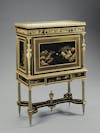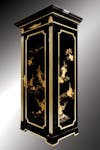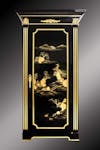In the mid-18th century, after several decades of the ornamental decadence of the rocaille style, a great many in the aristocracy andgrande bourgeoisie(upper class or gentry) sought greater simplicity in their décors. The Louis XVI style was poised to appear, two decades before the reign of the same name, heralded by the Transition style, which, as the name suggests, marked the shift from one to the other.
The start of such stylistic change – a dramatic neoclassical reaction to the excesses of the Louis XV style – was first and foremost due to the rediscovery of Herculaneum in 1738 and Pompeii in 1748. The Marquis de Marigny, brother to the Marquise de Pompadour, played an essential role in the Transition – which began at the end of the reign – by virtue of a trip he took to Italy between 1749 and 1751. Among those who joined him on the journey was the great neoclassical architect Soufflot who, upon his return to France, took the office ofDirecteur Général des Bâtiments du Roi(in essence, the king’s building superintendent), a position he held until 1773 and through which he promoted a return to classicism.








